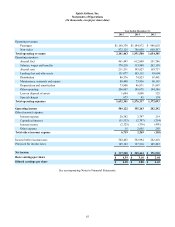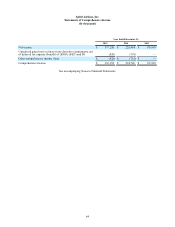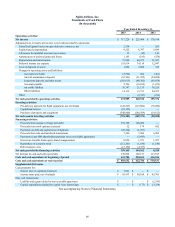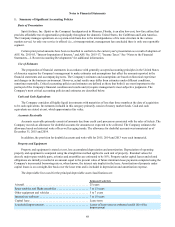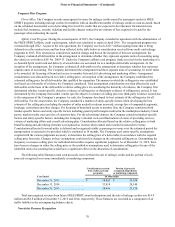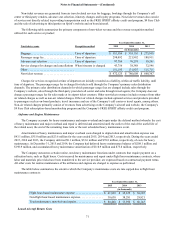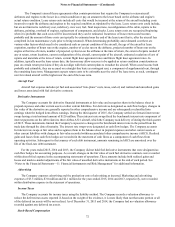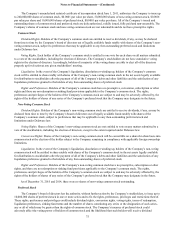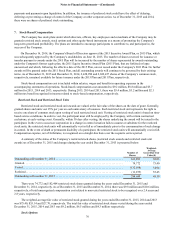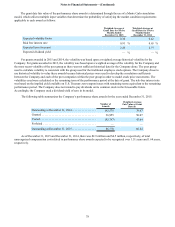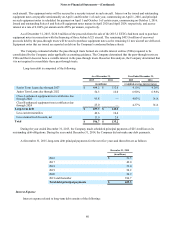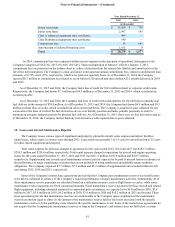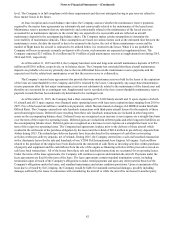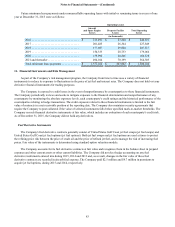Spirit Airlines 2015 Annual Report Download - page 73
Download and view the complete annual report
Please find page 73 of the 2015 Spirit Airlines annual report below. You can navigate through the pages in the report by either clicking on the pages listed below, or by using the keyword search tool below to find specific information within the annual report.Notes to Financial Statements—(Continued)
73
The Company recognizes cost of employee services received in exchange for awards of equity instruments based on the
fair value of each instrument at the date of grant. Compensation expense is recognized on a straight-line basis over the period
during which an employee is required to provide service in exchange for an award. The Company has issued and outstanding
restricted stock awards, stock option awards and performance share awards. Restricted stock awards are valued at the fair value
of the shares on the date of grant. To the extent a market price was not available, the fair value of stock awards was estimated
using a discounted cash flow analysis based on management’s estimates of revenue, driven by assumed market growth rates
and estimated costs as well as appropriate discount rates. These estimates are consistent with the plans and estimates that
management uses to manage the Company’s business. The fair value of share option awards is estimated on the date of grant
using the Black-Scholes valuation model. The fair value of performance share awards is estimated through the use of a Monte
Carlo simulation model. See “Notes to the Financial Statements—7. Stock-Based Compensation” for additional information.
Concentrations of Risk
The Company’s business may be adversely affected by increases in the price of aircraft fuel, the volatility of the price of
aircraft fuel, or both. Aircraft fuel was the Company’s single largest expenditure representing approximately 28%, 39% and
40% of total operating expenses in 2015, 2014 and 2013, respectively.
The Company’s operations are largely concentrated in the southeast United States with Fort Lauderdale being the highest
volume fueling point in the system. Gulf Coast Jet indexed fuel is the basis for a substantial majority of the Company’s fuel
consumption. Any disruption to the oil production or refinery capacity in the Gulf Coast, as a result of weather or any other
disaster, or disruptions in supply of jet fuel, dramatic escalations in the costs of jet fuel and/or the failure of fuel providers to
perform under fuel arrangements for other reasons could have a material adverse effect on the Company’s financial condition
and results of operations.
The Company’s operations will continue to be vulnerable to weather conditions (including hurricane season or snow and
severe winter weather), which could disrupt service or create air traffic control problems. These events may result in decreased
revenue and/or increased costs.
Due to the relatively small size of the fleet and high utilization rate, the unavailability of one or more aircraft and
resulting reduced capacity could have a material adverse effect on the Company’s business, results of operations and financial
condition.
As of December 31, 2015, the Company had four union-represented employee groups that together represented
approximately 73% of all employees. As of December 31, 2014, the Company had four union-represented employee groups
that together represented approximately 67% of all employees. A strike or other significant labor dispute with the Company’s
unionized employees is likely to adversely affect the Company’s ability to conduct business. Additional disclosures are
included in “Notes to the Financial Statements—14. Commitments and Contingencies.”
2. Recent Accounting Developments
In May 2014, the Financial Accounting Standards Board (the FASB) issued Accounting Standards Update (ASU) No.
2014-09, (ASU 2014-09), "Revenue from Contracts with Customers." The objective of ASU 2014-09 is to establish a single
comprehensive model for entities to use in accounting for revenue arising from contracts with customers. ASU 2014-09 will
supersede most of the existing revenue recognition guidance, including industry-specific guidance. The core principle of ASU
2014-09 is that an entity recognizes revenue to depict the transfer of promised goods or services to customers in an amount that
reflects the consideration to which the entity expects to be entitled in exchange for those goods or services. In applying the new
guidance, an entity will (1) identify the contract(s) with a customer; (2) identify the performance obligations in the contract; (3)
determine the transaction price; (4) allocate the transaction price to the contract's performance obligations; and (5) recognize
revenue when (or as) the entity satisfies a performance obligation. ASU 2014-09 applies to all contracts with customers except
those that are within the scope of other topics in the FASB Accounting Standards Codification. The new guidance is effective
for annual reporting periods (including interim periods within those periods) beginning after December 15, 2017 for public
companies. Early adoption is permitted, but not before interim and annual reporting periods beginning after December 15,
2016. Entities have the option of using either a full retrospective or modified approach to adopt ASU 2014-09. The Company is
currently evaluating the new guidance and has not determined the full impact this standard may have on its financial statements
nor decided upon the planned method of adoption. While the Company is still evaluating the impact, it expects the accounting
for its frequent flier program to be impacted as the standard will no longer allow use of the incremental cost method when
recording revenue related to the Company's loyalty programs as well as the timing of recognition of certain ancillary fees to be
impacted by adoption of the standard.
In April 2015, the FASB issued ASU No. 2015-03 (ASU 2015-03), "Interest-Imputation of Interest." The standard
requires debt issuance costs to be presented on the balance sheet as a direct deduction from the related debt liability rather than


